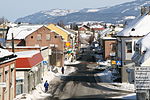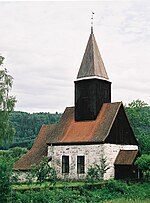Vestfossen Station
1871 establishments in NorwayRailway stations in Norway opened in the 1870sRailway stations in Øvre EikerRailway stations on the Sørlandet LineRailway stations opened in 1871

Vestfossen Station (Norwegian: Vestfossen stasjon) is a railway station located at the village of Vestfossen in Øvre Eiker, Norway on the railway Sørlandet Line. The station is served by local train service L12 between Kongsberg via Oslo to Eidsvoll operated by Vy.
Excerpt from the Wikipedia article Vestfossen Station (License: CC BY-SA 3.0, Authors, Images).Vestfossen Station
Sagveien, Øvre Eiker
Geographical coordinates (GPS) Address Nearby Places Show on map
Geographical coordinates (GPS)
| Latitude | Longitude |
|---|---|
| N 59.7344 ° | E 9.8671 ° |
Address
Vestfossen
Sagveien
3320 Øvre Eiker
Norway
Open on Google Maps







